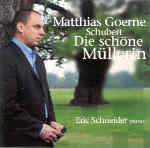Matthias Goerne is an outstanding lyric baritone whose warm, evenly produced voice and personal approach to his repertoire spur high expectations. But while there’s much to admire in this Die schöne Müllerin, high expectations are replaced by deep disappointment. The positives include an emotional identification that shines through in numerous of the cycle’s 20 songs, and some lovely soft singing, as in Morgengruss, one of many examples. Goerne can float ravishing pianissimos, as we hear in Der Neugierige. Unfortunately the price of those pianissimos is a Der Neugierige so painfully dragged out that the song is rendered almost unlistenable, its second stanza coming close to a full stop. You could overlook this if it were an isolated example, but it’s typical of Goerne’s approach. Thus the final songs of the cycle feature countless passages of breathtakingly beautiful soft singing, but at distended tempos that wreck their effect. At 5:07 Trockne Blumen is impossibly slow–Holzmaier takes 3:36 and Fischer-Dieskau in his 1961 EMI recording clocks in at 3:21. The final song, Des Baches Wiegenlied, is taken at a totally unworkable 9:27, encouraging the daydreaming that’s the last thing a performance of Die schöne Müllerin should induce. Other songs rocket along at a pace that’s unhealthy for both song and singer.
Lieder singers faced with Die schöne Müllerin often feel they have to differentiate themselves from the competition, and Goerne appears to have chosen the route of maximum tempo contrasts. This debilitating shift from the glacial to the overwrought is compounded by his loss of tonal quality in many of those unnecessarily loud, fast passages. When Goerne goes into overdrive he gives us hectic singing that comes perilously close to the barking we associate with overly aggressive Wagnerians. His low notes sound unnaturally puffed up and he outdoes late-period Fischer-Dieskau in hectoring. Goerne’s accompanist follows the same path, with aggressive, wearying playing in the faster songs. The engineers produce an odd sonic picture too, miking the singer close enough to catch sibilants and intakes of breath while adding reverb to create a sense of distance, the combination yielding a weird effect–yet matching this misguided interpretation.
































